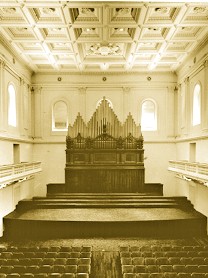 Before the Sala Accademica was built, concerts organized by the Accademia right after the Unification of Italy took place in Sala Dante, and briefly also in the deconsecrated chapel of the Orsoline Convent in Via Vittoria. Sala Accademica was constructed between 1886 and 1894; it was designed by architect Pompeo Coltellacci and could seat about 1,200 people.
Before the Sala Accademica was built, concerts organized by the Accademia right after the Unification of Italy took place in Sala Dante, and briefly also in the deconsecrated chapel of the Orsoline Convent in Via Vittoria. Sala Accademica was constructed between 1886 and 1894; it was designed by architect Pompeo Coltellacci and could seat about 1,200 people.
The stage could hold a 70-member orchestra and a chorus of 130. It was also equipped with an organ which had 31 registers, 3 manuals and chromatic pedals, made by the German firm of Walcker & Co of Ludwigsburg. The hall was inaugurated with a concert of music by Palestrina performed by the Accademia Chorus conducted by Raffaele Terziani on 2 February 1895, the date which the Accademia has come to consider the founding of its regular concert seasons. These seasons received fresh impetus under the guidance of the new president, Count Enrico di San Martino e Valperga, who was elected in December 1895 after the death of Ruggero Bonghi.
In 1907, on the occasion of his first appearance in Rome, Gustav Mahler conducted two concerts in the Sala Accademia of music by Beethoven, Wagner, Berlioz, Weber and Tchaikovsky. During ensuing intervals, the hall underwent some modifications, including elimination of the royal box and construction of the current balcony, but overall it retained almost unaltered its original neo-Renaissance style, along the lines of other historical European concert halls of the time such as the Musikverein in Vienna. Starting in 1895 the Accademia began to progressively number the concerts it gave, a practice which remained operative until 1971. Between February 1895 and May 1909, the Accademia Annuary recorded 206 symphonic and chamber concerts.